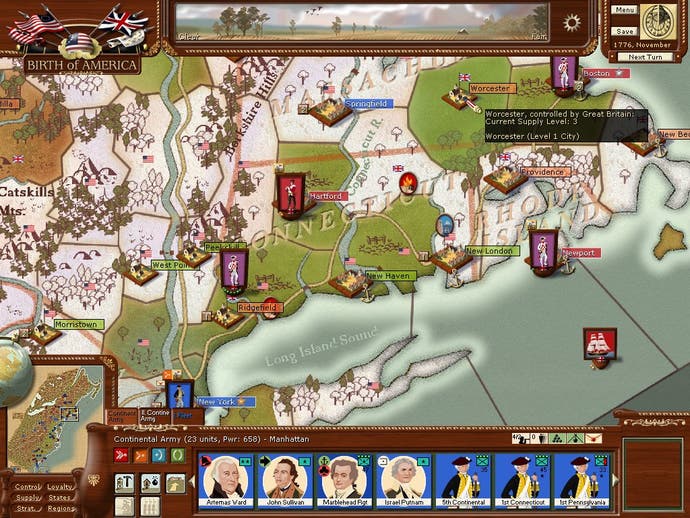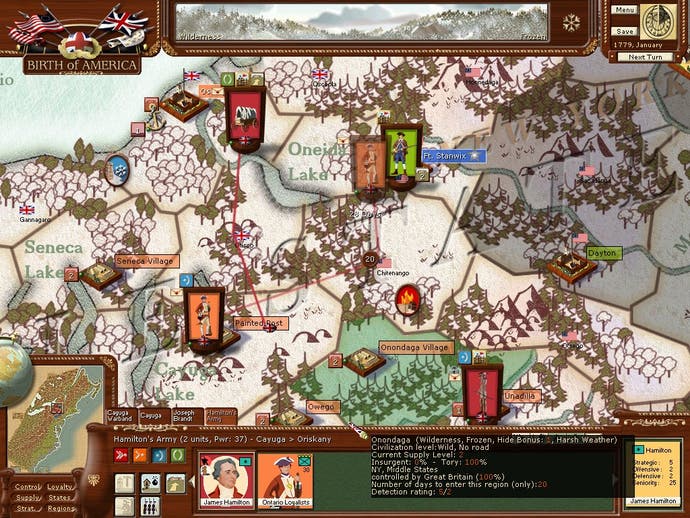Birth of America
The Yanks are revolting.
Britain has a great way of dealing with the less glorious episodes in its colourful past - it doesn't talk about them. Ask the average Brit to name a conflict that ended in defeat for the UK and chances are they'll struggle to come up with one. I'd probably struggle too if it wasn't for the fact I'd just spent a pleasant and highly educational week in the company of American War of Independence wargame Birth of America.
BoA uses regiment-sized units, one-month turns and a pretty cellular map of the eastern flank of North America to explore the fascinating story of Britain's failed attempts to crush revolution in its American territories in the late 1700s. For those that don't know the history, thirteen colonies, riled by some heavy-handed taxation, got shirty and declared independence. The war that followed raged for eight bloody years. Ultimately the involvement of French and Spanish forces on the US side tipped the balance in favour of the rebels. Grumpy British dignitaries signed a peace treaty in Paris in 1783.
Patriot games

The above you could have gleaned from Wikipedia in seconds, but what BoA gives you that can't be got easily elsewhere is first-hand insights into the strategic challenges that faced men like George Washington (American commander-in-chief) and William Howe (Britain's biggest military cheese). Playing as the Brits you get to grapple with the problem of combating a canny and dispersed enemy that relies on militia and strong grassroots support. Playing as the 'Patriots' you learn to harass and goad the powerful, well-trained Redcoat armies and their Hessian mercenary allies. Factors that both sides had to contend with like bitter winters, the importance of supply, and quality of generals, also loom pleasingly large in the game. Though the mechanics of play are simple and traditional - plot army movements then sit back and watch as the CPU calculates any battle results - BoA manages to feel both fresh and subtle thanks to all the conflict-specific historical detail.
The French designers have deliberately kept the focus firmly on the fighting. Besides the odd bit of fort and supply depot erection there's no construction to distract you. Economics and diplomacy are non-existent. Recruitment is all automated (periodically new blood arrives from Europe and states spawn militia units) Given this combat fixation, it's slightly disappointing that the battles themselves aren't more involving. Besides setting behavioural postures and attempting ambushes, there are no real tactical options. Where other strategic wargames like Forge of Freedom, For Liberty!, and Medieval 2: Total War have their own embedded battle modes, BoA selfishly keeps all the combat choreography to itself.
During the resolution phase of each turn when both sides' orders are simultaneously executed, scrap summaries appear on the screen for player perusal. These tell a tale of sorts with a combination of event icons and casualty reports, but it's all a bit dry and abstract. Considerable imagination is required to turn a string of bald statements like
"Your units opened fire at an initial range of 6."
"At the start of combat there were 4 of your sub-units that benefited from favourable ground."
and
"Your luck rate on the combat dice rolls is 72."
into a memorable mental movie. Give me masses of blue and red dots mingling on a green plain. Give me bullet holes in unit cards. Give me a scrawled dispatch or two... there are plenty of more imaginative, more evocative ways to present battle data.
Blast of the Mohicans

The fact that developer AGEOD didn't spend months fashioning a tactical layer may well explain the unusually competent AI and the impressive build-quality of the scenarios. Whether you're playing one of the mammoth 100-turn American Revolution or French & Indian War scenarios or one of the dozen or so smaller alternatives (most of which break the AR down into regional chunks) you're going to encounter pleasingly plausible adversaries and cunningly stacked victory conditions. Very occasionally a computer-controlled adversary will foolishly hurl an army at a well-defended fort or leave a strategic town unguarded, but most of the time they are sharp as Bowie knives.
A little command incompetence is actually intentional. The game models around 100 historical leaders as individual units. Each character has a rank, a set of command stats, and, sometimes, authentic talents and weaknesses too. When preparing for a major Spring offensive, a guerrilla raid, or a long siege, you don't just lump together a few regiments with a few supply wagons and set off, you mull over leader selections. Burgoyne is a slowcoach so he can stop here for the moment. Butler is a master of the ambush - I'll combine him with these irregulars and sit him in the woods at Snow Shoe. Hamilton, he's a proven Indian fighter, he and his men can go south and take on the Iroquois... The presence of identifiable leaders together with features like unit veterancy adds a welcome pinch of human interest to long campaigns. Inevitably you end up following the fortunes of able favourites and arch foes.
Reinforcements en-route

Considering the scale of the core scenarios it's not surprising the devs went with play-by-email for their multiplayer. The system is a little fiddly, but seems to work well enough. By the time you're confident enough to move onto a flesh-and-blood adversary there's a good chance AGEOD's second game will be on the shelves. The lyrically titled Our Hearts Were Touched With Fire, an American Civil War treatment, will use an improved version of the BoA engine. Promisingly, there's forum talk of some of the improvements being retrofitted to BoA in the Spring via a free patch.
For those willing to tolerate a few boardgame-style abstractions, a little thumb-twiddling (sometimes turn calculations can take a minute or two) and the odd bit of bafflement (fundamentally simple, the game does have a few confusing elements like supply simulation), purchase options are pretty diverse. Download versions are available via Steam, Matrixgames.com and AGEOD's own site for around £20. If you scour online retailers and high street stores you'll probably find boxed copies in the £10 to £15 price bracket. £10 for a wargame so solidly constructed and in tune with its unusual subject matter? That's downright scandalous.
